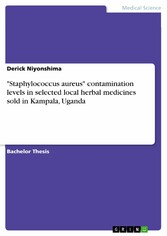'Staphylococcus aureus' contamination levels in selected local herbal medicines sold in Kampala, Uganda
von: Derick Niyonshima
GRIN Verlag , 2018
ISBN: 9783668719149
, 53 Seiten
Format: PDF
Kopierschutz: frei
Preis: 18,99 EUR
eBook anfordern 
Mehr zum Inhalt

'Staphylococcus aureus' contamination levels in selected local herbal medicines sold in Kampala, Uganda
Bachelor Thesis from the year 2016 in the subject Health - Public Health, grade: 75.0, Makerere University, course: Biomedical Laboratory Technology, language: English, abstract: Herbal medicine use in Uganda and the world at large is at its peak because of the documented efficacy, effectiveness, cheap cost and less side effects. The estimates of herbal medicine users in the world is 80% and 60% in Uganda, yet with all this demand, less effort has been put to ensure that they are free from bacterial contamination. The study therefore aimed at determining Staphylococcus aureus contamination of selected liquid herbal medicines sold in Kampala, Uganda with the following specific objectives; to provide an update on the different local herbal medicines sold in Kampala, Uganda and the conditions they treat; to determine Staphylococcus aureus contamination levels of selected liquid local herbal medicines sold in Kampala, Uganda; and to establish the antibacterial susceptibility patterns of isolated Staphylococcus aureus. A questionnaire was used to collect data on the different local herbal medicines sold in Kampala, Uganda. To determine levels of Staphylococcus aureus contamination, microbial culture was performed on 30 selected liquid herbal medicine samples. In addition Staphylococcus aureus susceptibility patterns were determined by subjecting isolated Staphylococcus aureus species to gentamicin 10?g, chloramphenicol 30 30?g ampicillin 10?g, penicillin 10U and tetracycline 30?g. A total of one hundred and seventy local herbal medicines were identified and classified into twenty five categories basing on conditions they treat. I therefore recommend that herbal medicines should be tested for bacterial quality by regulatory bodies before being sold to patients to avoid Staphylococcus aureus infection hence avoiding treatment costs. In addition, herbal medicine practitioners should embark on good manufacturing practices to avoid contamination of herbal medicines.











